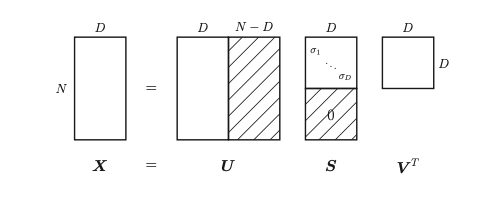Singular value decomposition (SVD)¶
Generalize eigen value decomposition for any matrix.
›
\(X_{N \times D}\)
\(U_{N \times N}\) is orthonormal and is the eigen vectors of \(XX^T\)
\(S_{N \times D}\) are the singular values where there is only \(min(N,D)\) non zero.
\(V_{D \times D}\)is orthonormal and it is the eigne vectors of \(X^TX\) (This is just the empirical covariance)

In general we do not need to compute all the columns of \(U\) since they will be multiplied by zero. Thin SVD (Economy sized SVD) avoids computing those.
Connection between eigen vectors and singular values¶
Given a matrix \(X = USV^T\) we have:
\(D = S^2\) contains the square singular values
Hence $\( (X^TX) V = VD \)$
That makes \(V\) the eigen vectors of \(X^TX\), the right singular vectors of X, and \(D\) are its eigen values.
Similarly:
This makes \(U\) the eigen vectors of U, and the left singular vectors of X
There is a special variant of SVD called truncated SVD which computes only the first L singular values. And gives the option to perform an rank L low rank approximation.
